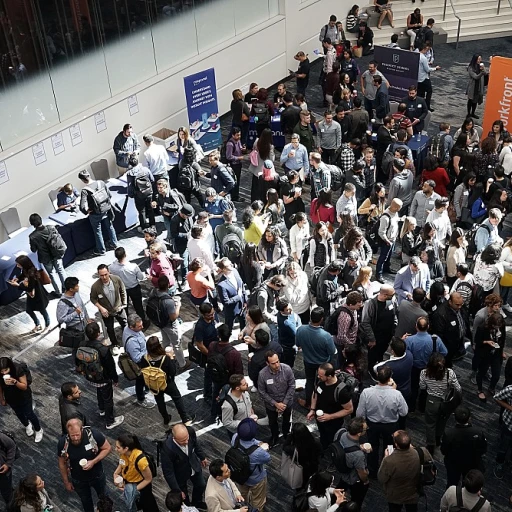
Understanding the HR Tech Stack
In the realm of human resources management, the adoption of a comprehensive HR technology stack is indispensable for enhancing operational efficiency. Understanding this tech landscape is crucial for any organization aiming to streamline its HR processes. The technology stack in HR encompasses a wide array of tools and platforms that facilitate various HR functions such as payroll, employee engagement, and performance management.
Why a Tech Stack is Vital for HR Operations
Modern organizations face the challenge of handling complex HR tasks in real time. A technological stack provides a centralized system, offering data-driven insights and enabling data tracking, compliance management, and employee data analysis. These systems are pivotal in improving the employee experience and ensuring operational efficiency.
With a robust stack, HR managers have the capacity to oversee payroll benefits, applicant tracking, and learning management more efficiently. The integration of management software not only enhances decision-making processes but also elevates employee engagement through tailored solutions that cater to specific organizational needs.
Technological Components Enhancing HR Functions
To better understand the HR technology landscape, consider the key software elements that often comprise the tech stack:
- System HRIS: A centralized management system that houses employee data critical for strategic planning and decision making.
- Performance Management Tools: These solutions track and assess employee performance metrics, enabling management to make informed decisions on development and reward strategies.
- Payroll Systems: Automation of payroll processes ensures seamless and compliant handling of employee payments and benefits.
As the HR landscape evolves, technological tools continue to redefine how organizations engage and manage their workforce. Understanding the essential components of a comprehensive HR tech setup can significantly impact an organization's capacity to recruit, retain, and develop its talent pool. For those seeking to delve deeper into the evolving technological landscape, explore more about embracing technological advancements in the HR sphere.
Key Components of an Effective HR Tech Stack
Core Elements for an Effective HR Technology Implementation
The success of an HR tech stack largely depends on its key components, which work together to streamline operations and enhance the employee experience. As organizations look to modernize their HR processes, understanding these fundamental elements becomes crucial.
An applicant tracking system (ATS) is a foundational component that simplifies the recruitment process by managing candidate data effectively. It enables HR managers to identify talent swiftly, ensuring a seamless experience for potential employees.
Performance management tools are essential for evaluating employee performance and engagement. By utilizing data-driven insights, these solutions help in informed decision making, fostering a culture of continuous feedback and development.
An integrated HR management system (HRIS) can centralize employee data, payroll, and benefits administration. A user-friendly interface is key to ensuring ease of access and compliance, which is critical for both employees and management. A well-rounded HRIS often incorporates payroll benefits and time management functionalities to optimize efficiency.
Learning management systems are increasingly being integrated into HR tech stacks, facilitating ongoing employee development and training. These platforms support enhanced employee engagement and ensure that the workforce stays competitive in a rapidly evolving job market.
Incorporating real-time data analytics provides organizations with a competitive edge by improving decision-making capabilities. Data analytics tools help uncover insights into employee performance and engagement, driving proactive management interventions.
Adoption of these core components not only addresses pain points in HR processes but also enhances the organization’s ability to attract and retain top talent. To further understand how these elements can transform HR operations, exploring the expertise in digital marketing and HR synergy can provide valuable insights for building a comprehensive tech stack.
Challenges in Implementing an HR Tech Stack
Overcoming Obstacles in Building an Effective HR Tech Infrastructure
When diving into the realm of enhancing HR operations with a comprehensive tech stack, businesses often encounter hurdles that can make implementation challenging. It’s crucial to address these obstacles methodically to ensure the system’s success. Here are some common challenges and how to tackle them:- Integration Complexity: One of the most significant pain points is integrating new systems with existing platforms. Ensuring that different tools communicate seamlessly is essential for optimizing data exchange processes. Utilizing a robust Human Resource Information System (HRIS) can mitigate integration issues and enhance real-time data flow.
- User Adoption Resistance: Employees may be hesitant to adopt new technology. To ease this transition, offering comprehensive training and highlighting the benefits such as improved employee experience and streamlined performance management is important. Tailored learning management strategies can empower staff, subsequently enhancing engagement.
- Ensuring Compliance: Maintaining regulatory compliance is paramount when implementing any HR software solution. The organization must guarantee that the tech stack adheres to data protection and labor laws. Platforms should include features that facilitate adherence to compliance requirements.
- Balancing Cost and Benefit: Determining the right investment in technology without overextending budgets can be daunting. Undertaking a data-driven approach to evaluate potential solutions against organizational needs ensures that the selected tech stack offers maximum benefits at a sustainable cost.
- Data Management: As organizations accumulate vast employee data, safeguarding and utilizing this information effectively is a challenge. The tech stack should encompass a robust data management system that supports informed decision making and contributes to organizational success.
Leveraging Data Analytics in HR
Data-Driven Decision Making in Human Resources
In today's rapidly changing organization landscapes, harnessing data analytics plays a pivotal role in driving successful HR operations. By leveraging the power of data-driven insights, companies can significantly enhance their performance management processes and optimize their technology stack.- Employee Data for Insightful Decision Making: Organizations can use employee data to unlock valuable insights into engagement, performance, and satisfaction. Access to real-time analytics allows HR professionals to make informed decisions about workforce strategies, effectively addressing the pain points and enhancing employee experiences.
- Boosting Employee Engagement and Performance: Incorporating advanced data tools within your system can provide deeper insights into employee engagement levels. Platforms that track engagement scores and feedback help organizations understand what drives employee satisfaction and where improvement is needed for better outcomes.
- Optimizing the HR Tech Stack with Analytics: By integrating management software solutions and data analytics tools, organizations can continuously refine their tech stacks. This ensures that they are aligned with business goals, ultimately improving compliance, processes, and efficiency of HR management systems.
- Streamlining the Payroll Benefits and Compliance: Utilizing learning management and applicant tracking systems within your technology stack enables seamless payroll, benefits administration, and ensures compliance with regulations. These technologies provide comprehensive insights and automate routine tasks, releasing time for strategic initiatives.
- Ensuring a User-Friendly Experience: Creating a user-friendly environment for HR tools ensures better engagement from employees and management alike. Solutions must allow easy access to data, enabling informed decision making and fostering a collaborative workplace culture.
Future Trends in HR Technology
Navigating the Course of Future HR Technologies
The rapid evolution of technology presents numerous opportunities for organizations aiming to enhance their HR operations. As the landscape of human resources continues to evolve, staying ahead of future trends is crucial for maintaining efficient and effective HR processes. 1. Integration and Automation Organizations are increasingly looking towards integrating various HR tech stack components to increase efficiency. A fully integrated system allows for smooth communication between different tools and software, enhancing real-time data flow, thus aiding in more informed decision making. Automation of repetitive tasks such as payroll and employee data management can lead to significant time savings and reduce errors, allowing HR teams to focus on strategic initiatives like improving employee experience. 2. Embracing Advanced Analytics Advanced data analytics within HR technology stacks are becoming the norm, providing insights into employee engagement, performance management, and overall organizational health. By utilizing data-driven solutions, HR professionals can identify trends, predict employee behavior, and tailor strategies to improve workforce satisfaction and productivity. 3. Focus on Employee Engagement Platforms Investing in platforms that boost employee engagement is pivotal. As organizations adopt newer technologies, focus remains on user-friendly management systems that enhance the overall employee experience. From learning management tools to comprehensive engagement platforms, these technologies play a crucial role in retaining talent and fostering a thriving work environment. 4. Enhanced Compliance through Technology With increasing regulatory demands, utilizing technology to streamline compliance processes is more important than ever. Software solutions focused on compliance management help organizations stay updated with changing laws and regulations, minimizing the risk of non-compliance and safeguarding the organization. 5. Adoption of Flexible HR Solutions The adoption of flexible, scalable HR solutions allows organizations to tailor their human resources processes according to their unique needs. As companies grow and evolve, the need for adaptable solutions that can efficiently manage everything from applicant tracking to payroll benefits becomes evident. Exploring the potential of future HR technology trends is essential for any organization aiming to optimize its HR tech stack and stay competitive in the marketplace. Organizations should remain vigilant, continuously evaluating and shaping their technology strategy to ensure it aligns with their overarching business objectives.Best Practices for Optimizing Your HR Tech Stack
Essential Strategies for Success
The efficacy of an HR tech stack is not solely dependent on having the best tools, but also in how they are optimized to meet the specific needs of an organization. Here are some best practices to consider:
- Align the Tech Stack with Organizational Goals: Ensure that the HR technology stack aligns with the overall strategic objectives of the organization. This alignment facilitates data-driven decision making and enhances employee engagement by ensuring that tech solutions support key objectives, such as performance management and employee experience.
- Foster User-friendly Solutions: The success of any HR software or management system depends largely on user adoption. Choose tools and platforms that are intuitive and easy to navigate. Employee engagement increases when systems are user-friendly, leading to seamless integration into daily processes.
- Pursue Continuous Improvement: The dynamic nature of technology calls for constant evaluation and improvement of the tech stack. Regularly assess the performance of existing systems, identify pain points, and make the necessary adjustments to maintain a robust technology stack.
- Enhance Data Integration and Security: Proper management of employee data is critical. Ensure that all platforms within the tech stack integrate seamlessly to provide comprehensive insights across functions like compliance, payroll, and learning management. Protect data with strong security measures to comply with legal requirements and bolster organizational trust.
- Leverage Real-time Data for Decision Making: Utilize real-time data analytics to make informed decisions quickly. This practice enhances response times to emerging issues and helps in strategic areas such as applicant tracking, performance management, and employee engagement solutions.
- Promote Cross-functional Collaboration: HR systems should facilitate communication and collaboration across different departments. A well-integrated HR tech stack enables seamless interaction between HR and other organizational functions, thus improving overall efficiency and employee experience.
By following these strategies, organizations can optimize their HR tech stacks, ensuring that they are effective, efficient, and aligned with overall business goals. Strategic investments in technology can lead to enhanced HR processes, improved employee engagement, and ultimately, greater organizational success.












